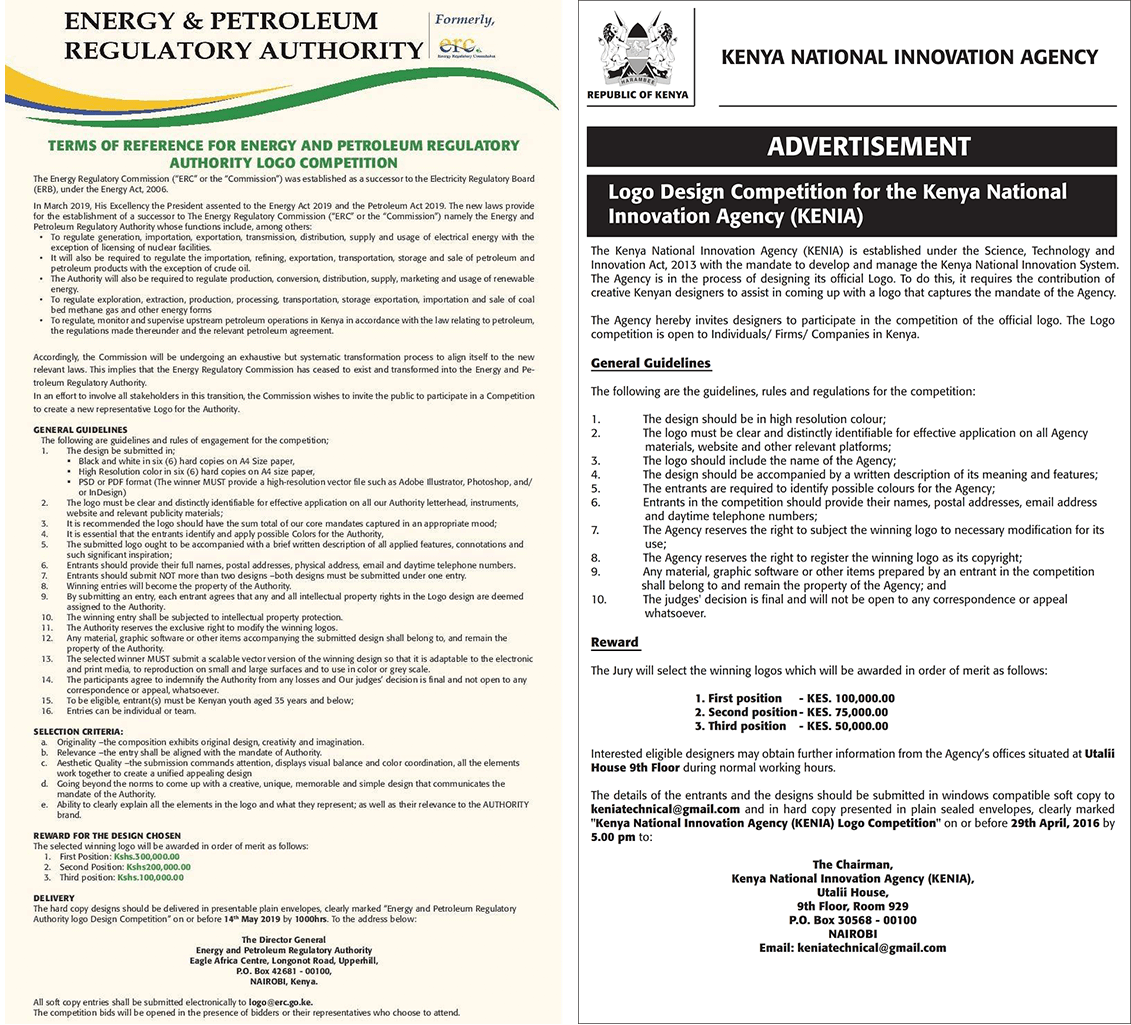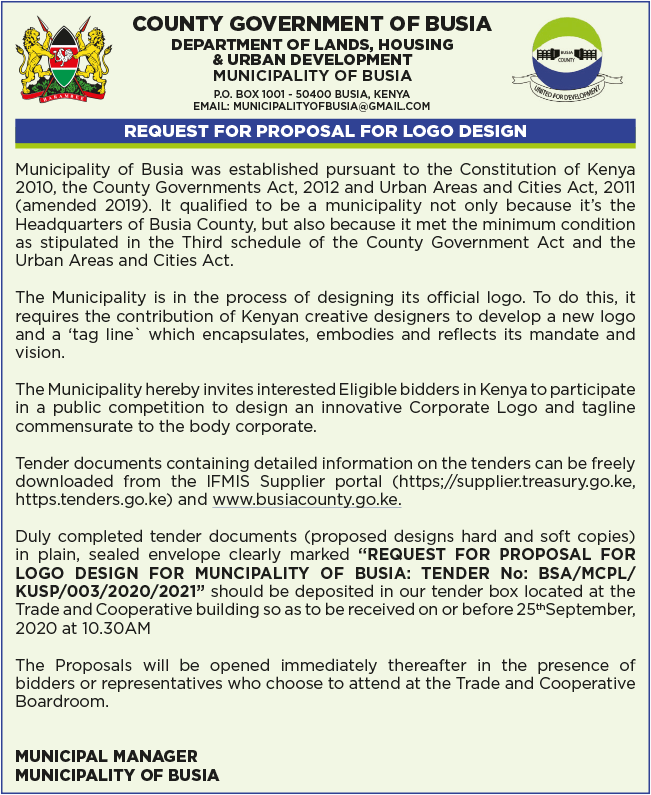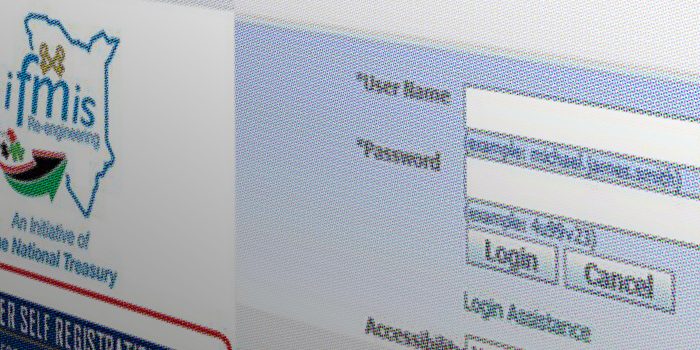Design Competition as a Procurement Method
For obtaining competitive tenders for services which are creative in nature and which require that part of the services be carried as part of the tender.

A Design Competition is defined as a ‘means a procurement procedure for obtaining competitive tenders for services which are creative in nature and which require that part of the services be carried as part of the tender to facilitate evaluation of the tenders and such services may include architecture, landscaping, engineering, urban design projects, urban and regional planning, fine arts, interior design, marketing, advertising and graphic designs’.
Simply put, design competitions are mainly used as a procurement method for the purpose of determining the best architectural, physical planning, engineering, graphic or any other design scheme for its use.
Here are examples design competition advertisements from the Kenya National Innovation Agency (KENIA) and from the Energy & Petroleum Regulatory Authority that ran in 2016 and 2019 respectively:

Here’s a more recent example of an advertisement for a public competition to design a corporate logo and tagline for the County Government of Busia:

In this method of procurement, it is important to note that you will find part of the services are already a part of the tender. This is because the overall shape and the details of the contract are offered by the contractual partner (basically through the creation of a proposed concept design) and not by the procuring entity .
Further, the designers of the best three assessed design schemes usually receive an honorarium and are legally obliged to transfer all intellectual property rights applicable to the design to the procuring entity running the competition.
Here’s what the Procurement Laws say about Design Competition
The Design Competition procurement method is governed by Section 100-101 of the Public Procurement and Asset Disposal Act Revised Edition 2016 as outlined below:
-
- In design competitions, a procuring entity shall —
- invite design proposals through a public advertisement;
- ensure the preparation of an invitation sets out the following—
- the name and address of the procuring entity;
- the tender number assigned to the procurement proceedings by the procuring entity;
- description of technical and functional needs;
- an explanation of where and when tenders shall be submitted and where and when the tenders will be opened;
- a statement that those submitting tenders or their representatives may attend the opening of the design proposals;
- a statement that a copyright or other intellectual property of the top three shall vest in the State.
- The evaluation of design proposals shall be undertaken by an evaluation committee established under the Act.
- The design process shall be as prescribed in the The Public Procurement And Asset Disposal Regulations, 2020.
- Prior to publishing an invitation notice, an accounting officer of a procuring entity shall prepare tender documents and appoint as part of an ad hoc evaluation committee instituted pursuant to the Act at least one independent lay assessor, and technical assessors recommended by the professional regulatory body governing the design competition.
- The best three assessed design schemes shall receive as a prize an honorarium as provided for in the internal policies of the procuring entity subject to the guidelines set out in the applicable county or national level or the Regulations to the Act.
- In participating in design competitions, all bidders shall undertake to transfer all copyrights, intellectual property rights and patents relating to their designs to the procuring entity.
- Upon completion of the design competition, all the submitted design schemes shall become property of the procuring entity. (shall only apply to the best three assessed design schemes provided for in section 101 (5) of the Act.).
- In design competitions, a procuring entity shall —
The 2020 Regulations go a step further to provide a step by step guide that should be followed by any public procuring entity considering the use of this procurement method as follows:
88. (1) The accounting officer of a procuring entity shall take such steps as are reasonable to bring the invitation to tender to the attention of those who may wish to submit tenders.
-
- Preparation of tender documents.
- Appointment of independent assessors shall be in accordance with section 101(4) of the Act.
- Issuance of the notice of invitation to participate in the design competition.
- Submission of design proposals by the tenderers.
- Opening of bids.
- Appointment of an ad hoc evaluation committee in accordance with section 101 (4) of the Act.
- Evaluation of the design proposals in accordance with the criteria set out in the bid documents.
- Submission of design competition report to the head of procurement function for review.
- Preparation of a professional opinion by the head of the procurement function who shall submit it to the accounting officer for approval.
- Notification of results to all bidders and declaration of the best three design schemes.
- Payment of honorarium as provided in the bid document inviting the design competition.
The Maximum Level of Expenditure for the use of Design Competition
Guided by the Second Schedule of the Public Procurement and Assets Disposal Regulations (2020), where the procurement method is Design Competition, the threshold matrix is provided as follows:
| Procurement Method – Design competition (section 100 of the Act) | ||
| Goods | Works | Services |
| No Maximum expenditure under this method provided the conditions under this section are met | No Maximum expenditure under this method provided the conditions under this section are met | No Maximum expenditure under this method provided the conditions under this section are met |
| No Minimum | No Minimum | No Minimum |
This article is part of the Procurement Methods blog series.







